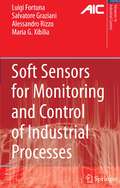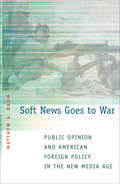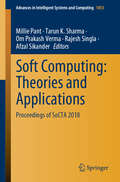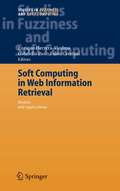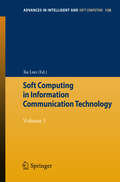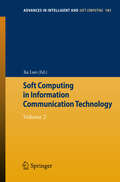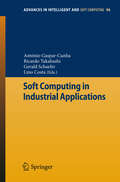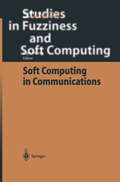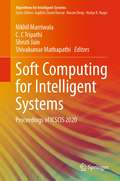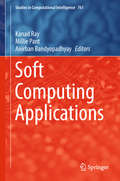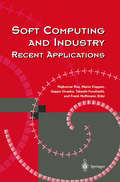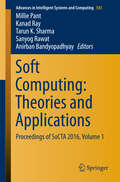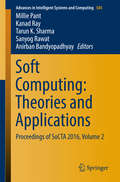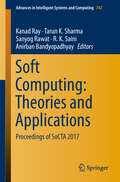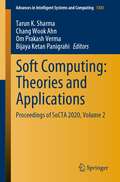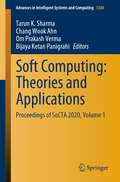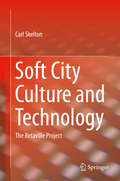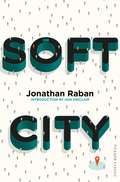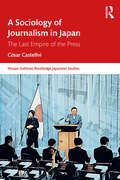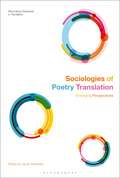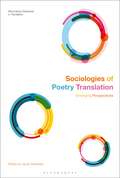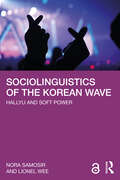- Table View
- List View
Soft Sensors for Monitoring and Control of Industrial Processes (Advances in Industrial Control)
by Luigi Fortuna Salvatore Graziani Alessandro Rizzo Maria Gabriella XibiliaThis book reviews current design paths for soft sensors, and guides readers in evaluating different choices. The book presents case studies resulting from collaborations between the authors and industrial partners. The solutions presented, some of which are implemented on-line in industrial plants, are designed to cope with a wide range of applications from measuring system backup and what-if analysis through real-time prediction for plant control to sensor diagnosis and validation.
Soft News Goes to War: Public Opinion and American Foreign Policy in the New Media Age
by Matthew A. BaumThe American public has consistently declared itself less concerned with foreign affairs in the post-Cold War era, even after 9/11, than at any time since World War II. How can it be, then, that public attentiveness to U.S. foreign policy crises has increased? This book represents the first systematic attempt to explain this apparent paradox. Matthew Baum argues that the answer lies in changes to television's presentation of political information. In so doing he develops a compelling "byproduct" theory of information consumption. The information revolution has fundamentally changed the way the mass media, especially television, covers foreign policy. Traditional news has been repackaged into numerous entertainment-oriented news programs and talk shows. By transforming political issues involving scandal or violence (especially attacks against America) into entertainment, the "soft news" media have actually captured more viewers who will now follow news about foreign crises, due to its entertainment value, even if they remain uninterested in foreign policy. Baum rigorously tests his theory through content analyses of traditional and soft news media coverage of various post-WWII U.S. foreign crises and statistical analyses of public opinion surveys. The results hold key implications for the future of American politics and foreign policy. For instance, watching soft news reinforces isolationism among many inattentive Americans. Scholars, political analysts, and even politicians have tended to ignore the soft news media and politically disengaged citizens. But, as this well-written book cogently demonstrates, soft news viewers represent a largely untapped reservoir of unusually persuadable voters.
Soft News Goes to War: Public Opinion and American Foreign Policy in the New Media Age
by Matthew A. BaumThe American public has consistently declared itself less concerned with foreign affairs in the post-Cold War era, even after 9/11, than at any time since World War II. How can it be, then, that public attentiveness to U.S. foreign policy crises has increased? This book represents the first systematic attempt to explain this apparent paradox. Matthew Baum argues that the answer lies in changes to television's presentation of political information. In so doing he develops a compelling "byproduct" theory of information consumption. The information revolution has fundamentally changed the way the mass media, especially television, covers foreign policy. Traditional news has been repackaged into numerous entertainment-oriented news programs and talk shows. By transforming political issues involving scandal or violence (especially attacks against America) into entertainment, the "soft news" media have actually captured more viewers who will now follow news about foreign crises, due to its entertainment value, even if they remain uninterested in foreign policy. Baum rigorously tests his theory through content analyses of traditional and soft news media coverage of various post-WWII U.S. foreign crises and statistical analyses of public opinion surveys. The results hold key implications for the future of American politics and foreign policy. For instance, watching soft news reinforces isolationism among many inattentive Americans. Scholars, political analysts, and even politicians have tended to ignore the soft news media and politically disengaged citizens. But, as this well-written book cogently demonstrates, soft news viewers represent a largely untapped reservoir of unusually persuadable voters.
Soft Computing: Proceedings of SoCTA 2018 (Advances in Intelligent Systems and Computing #1053)
by Millie Pant Tarun K. Sharma Om Prakash Verma Rajesh Singla Afzal SikanderThe book focuses on soft computing and its applications to solve real-world problems in different domains, ranging from medicine and health care, to supply chain management, image processing and cryptanalysis. It includes high-quality papers presented at the International Conference on Soft Computing: Theories and Applications (SoCTA 2018), organized by Dr. B. R. Ambedkar National Institute of Technology, Jalandhar, Punjab, India. Offering significant insights into soft computing for teachers and researchers alike, the book inspires more researchers to work in the field of soft computing.
Soft Computing in Web Information Retrieval: Models and Applications (Studies in Fuzziness and Soft Computing #197)
by Enrique Herrera-Viedma Gabriella Pasi Fabio CrestaniThis book presents recent studies on the application of Soft Computing techniques in information access on the World Wide Web. The book is divided in four parts reflecting the areas of research of the presented works such as Document Classification, Semantic Web, Web Information Retrieval and Web Applications. The text demonstrates that Web Information Retrieval is a stimulating area of research where Soft Computing technologies can be applied satisfactorily.
Soft Computing in Information Communication Technology: Volume 1 (Advances in Intelligent and Soft Computing #158)
by Jia LuoThis is a collection of the accepted papers concerning soft computing in information communication technology. All accepted papers are subjected to strict peer-reviewing by 2 expert referees.The resultant dissemination of the latest research results, and the exchanges of views concerning the future research directions to be taken in this field makes the work of immense value to all those having an interest in the topics covered. The present book represents a cooperative effort to seek out the best strategies for effecting improvements in the quality and the reliability of Neural Networks, Swarm Intelligence, Evolutionary Computing, Image Processing Internet Security, Data Security, Data Mining, Network Security and Protection of data and Cyber laws.Our sincere appreciation and thanks go to these authors for their contributions to this conference. I hope you can gain lots of useful information from the book.
Soft Computing in Information Communication Technology: Volume 2 (Advances in Intelligent and Soft Computing #161)
by Jia LuoThis book is a collection of the accepted papers concerning soft computing in information communication technology. The resultant dissemination of the latest research results, and the exchanges of views concerning the future research directions to be taken in this field makes the work of immense value to all those having an interest in the topics covered. The present book represents a cooperative effort to seek out the best strategies for effecting improvements in the quality and the reliability of Fuzzy Logic, Machine Learning, Cryptography, Pattern Recognition, Bioinformatics, Biomedical Engineering, Advancements in ICT.
Soft Computing in Industrial Applications (Advances in Intelligent and Soft Computing #96)
by Lino Costa António Gaspar-Cunha Ricardo Takahashi Gerald SchaeferThe 15th Online World Conference on Soft Computing in Industrial Applications, held on the Internet, constitutes a distinctive opportunity to present and discuss high quality papers, making use of sophisticated Internet tools and without incurring in high cost and, thus, facilitating the participation of people from the entire world.The book contains a collection of papers covering outstanding research and developments in the field of Soft Computing including, evolutionary computation, fuzzy control and neuro-fuzzy systems, bio-inspired systems, optimization techniques and application of Soft Computing techniques in modeling, control, optimization, data mining, pattern recognition and traffic and transportation systems.
Soft Computing in Communications (Studies in Fuzziness and Soft Computing #136)
by Lipo WangSoft computing, as opposed to conventional "hard" computing, tolerates imprecision and uncertainty, in a way very much similar to the human mind. Soft computing techniques include neural networks, evolutionary computation, fuzzy logic, and chaos. The recent years have witnessed tremendous success of these powerful methods in virtually all areas of science and technology, as evidenced by the large numbers of research results published in a variety of journals, conferences, as weil as many excellent books in this book series on Studies in Fuzziness and Soft Computing. This volume is dedicated to recent novel applications of soft computing in communications. The book is organized in four Parts, i.e., (1) neural networks, (2) evolutionary computation, (3) fuzzy logic and neurofuzzy systems, and (4) kernel methods. Artificial neural networks consist of simple processing elements called neurons, which are connected by weights that may be adjusted during learning. Part 1 of the book has seven chapters, demonstrating some of the capabilities of two major types of neural networks, i.e., multiplayer perceptron (MLP) neural networks and Hopfield-type neural networks.
Soft Computing for Intelligent Systems: Proceedings of ICSCIS 2020 (Algorithms for Intelligent Systems)
by Nikhil Marriwala C. C Tripathi Shruti Jain Shivakumar MathapathiThis book presents high-quality research papers presented at the International Conference on Soft Computing for Intelligent Systems (SCIS 2020), held during 18–20 December 2020 at University Institute of Engineering and Technology, Kurukshetra University, Kurukshetra, Haryana, India. The book encompasses all branches of artificial intelligence, computational sciences and machine learning which is based on computation at some level such as AI-based Internet of things, sensor networks, robotics, intelligent diabetic retinopathy, intelligent cancer genes analysis using computer vision, evolutionary algorithms, fuzzy systems, medical automatic identification intelligence system and applications in agriculture, health care, smart grid and instrumentation systems. The book is helpful for educators, researchers and developers working in the area of recent advances and upcoming technologies utilizing computational sciences in signal processing, imaging, computing, instrumentation, artificial intelligence and their applications.
Soft Computing Applications: Proceedings Of Socta 2016, Volume 1 (Studies in Computational Intelligence #761)
by Kanad Ray Millie Pant Anirban BandyopadhyayThis book provides a reference guide for researchers, scientists and industrialists working in the area of soft computing, and highlights the latest advances in and applications of soft computing techniques in multidisciplinary areas. Gathering papers presented at the International Conference on Soft Computing: Theories and Applications (SoCTA 2016), which was held in Jaipur, Rajasthan, India, on December 28–30, 2016, it focuses on applying soft computing to solve real-life problems arising in various domains, from medical and healthcare to supply chain management, image processing and cryptanalysis. The term soft computing represents an umbrella term for computational techniques like fuzzy logic, neural networks and nature inspired algorithms. In the past few decades, there has been an exponential rise in the application of soft computing techniques to address complex and intricate problems in diverse spheres of life. The versatility of these techniques has made them a favourite among scientists and researchers alike.
Soft Computing and Industry: Recent Applications
by Rajkumar Roy Seppo Ovaska Takeshi Furuhashi Frank Hoffmann Mario KöppenSoft computing embraces various methodologies for the development of intelligent systems that have been successfully applied to a large number of real-world problems. Soft Computing in Industry contains a collection of papers that were presented at the 6th On-line World Conference on Soft Computing in Industrial Applications that was held in September 2001. It provides a comprehensive overview of recent theoretical developments in soft computing as well as of successful industrial applications. It is divided into seven parts covering material on: keynote papers on various subjects ranging from computing with autopoietic systems to the effects of the Internet on education; intelligent control; classification, clustering and optimization; image and signal processing; agents, multimedia and Internet; theoretical advances; prediction, design and diagnosis. The book is aimed at researchers and professional engineers who develop and apply intelligent systems in computer engineering.
Soft Computing: Proceedings of SoCTA 2016, Volume 1 (Advances in Intelligent Systems and Computing #583)
by Millie Pant Kanad Ray Tarun K. Sharma Sanyog Rawat Anirban BandyopadhyayThis book focuses on soft computing and its applications to solve real-life problems occurring in different domains ranging from medical and health care, supply chain management and image processing to cryptanalysis. It presents the proceedings of International Conference on Soft Computing: Theories and Applications (SoCTA 2016), offering significant insights into soft computing for teachers and researchers and inspiring more and more researchers to work in the field of soft computing. The term soft computing represents an umbrella term for computational techniques like fuzzy logic, neural networks, and nature inspired algorithms. In the past few decades, there has been an exponential rise in the application of soft computing techniques for solving complex and intricate problems arising in different spheres of life. The versatility of these techniques has made them a favorite among scientists and researchers working in diverse areas. SoCTA is the first international conference being organized at Amity University Rajasthan (AUR), Jaipur. The objective of SoCTA 2016 is to provide a common platform to researchers, academicians, scientists, and industrialists working in the area of soft computing to share and exchange their views and ideas on the theory and application of soft computing techniques in multi-disciplinary areas. The aim of the conference is to bring together young and experienced researchers, academicians, scientists, and industrialists for the exchange of knowledge. SoCTA especially encourages the young researchers at the beginning of their career to participate in this conference and present their work on this platform.
Soft Computing: Proceedings of SoCTA 2016, Volume 2 (Advances in Intelligent Systems and Computing #584)
by Millie Pant Kanad Ray Tarun K. Sharma Sanyog Rawat Anirban BandyopadhyayThis book focuses on soft computing and its applications to solve real-life problems occurring in different domains ranging from medical and health care, supply chain management and image processing to cryptanalysis. It presents the proceedings of International Conference on Soft Computing: Theories and Applications (SoCTA 2016), offering significant insights into soft computing for teachers and researchers and inspiring more and more researchers to work in the field of soft computing. >The term soft computing represents an umbrella term for computational techniques like fuzzy logic, neural networks, and nature inspired algorithms. In the past few decades, there has been an exponential rise in the application of soft computing techniques for solving complex and intricate problems arising in different spheres of life. The versatility of these techniques has made them a favorite among scientists and researchers working in diverse areas. SoCTA is the first international conference being organized at Amity University Rajasthan (AUR), Jaipur. The objective of SoCTA 2016 is to provide a common platform to researchers, academicians, scientists, and industrialists working in the area of soft computing to share and exchange their views and ideas on the theory and application of soft computing techniques in multi-disciplinary areas. The aim of the conference is to bring together young and experienced researchers, academicians, scientists, and industrialists for the exchange of knowledge. SoCTA especially encourages the young researchers at the beginning of their career to participate in this conference and present their work on this platform.
Soft Computing: Proceedings of SoCTA 2017 (Advances in Intelligent Systems and Computing #742)
by Kanad Ray Tarun K. Sharma Sanyog Rawat R. K. Saini Anirban BandyopadhyayThe book focuses on soft computing and its applications to solve real-world problems occurring in different domains ranging from medicine and healthcare, and supply chain management to image processing and cryptanalysis. It includes high-quality papers presented in the International Conference on Soft Computing: Theories and Applications (SoCTA 2017), organized by Bundelkhand University, Jhansi, India. Offering significant insights into soft computing for teachers and researchers alike, the book inspires more researchers to work in the field of soft computing.
Soft Computing: Proceedings of SoCTA 2020, Volume 2 (Advances in Intelligent Systems and Computing #1381)
by Tarun K. Sharma Chang Wook Ahn Om Prakash Verma Bijaya Ketan PanigrahiThis book focuses on soft computing and how it can be applied to solve real-world problems arising in various domains, ranging from medicine and healthcare, to supply chain management, image processing and cryptanalysis. It gathers high-quality papers presented at the International Conference on Soft Computing: Theories and Applications (SoCTA 2020), organized online. The book is divided into two volumes and offers valuable insights into soft computing for teachers and researchers alike; the book will inspire further research in this dynamic field.
Soft Computing: Proceedings of SoCTA 2020, Volume 1 (Advances in Intelligent Systems and Computing #1380)
by Tarun K. Sharma Chang Wook Ahn Om Prakash Verma Bijaya Ketan PanigrahiThis book focuses on soft computing and how it can be applied to solve real-world problems arising in various domains, ranging from medicine and healthcare, to supply chain management, image processing and cryptanalysis. It gathers high-quality papers presented at the International Conference on Soft Computing: Theories and Applications (SoCTA 2020), organized online. The book is divided into two volumes and offers valuable insights into soft computing for teachers and researchers alike; the book will inspire further research in this dynamic field.
Soft City Culture and Technology: The Betaville Project
by Carl SkeltonSoft City Culture and Technology: The Betaville Project discusses the complete cycle of conception, development, and deployment of the Betaville platform.Betaville is a massively participatory online environment for distributed 3D design and development of proposals for changes to the built environment– an experimental integration of art, design, and software development for the public realm. Through a detailed account of Betaville from a Big Crazy Idea to a working "deep social medium", the author examines the current conditions of performance and accessibility of hardware, software, networks, and skills that can be brought together into a new form of open public design and deliberation space, for and spanning and integrating the disparate spheres of art, architecture, social media, and engineering.Betaville is an ambitious enterprise, of building compelling and constructive working relationships in situations where roles and disciplinary boundaries must be as agile as the development process of the software itself. Through a considered account and analysis of the interdependencies between Betaville's project design, development methods, and deployment, the reader can gain a deeper understanding of the potential socio-technical forms of New Soft Cities: blended virtual-physical worlds, whose "public works" must ultimately serve and succeed as massively collaborative works of art and infrastructure.
Soft City: Picador Classic (Picador Classic #58)
by Jonathan RabanWith an introduction by Iain SinclairIn the city we can live deliberately: inventing and renewing ourselves, carving out journeys, creating private spaces. But in the city we are also afraid of being alone, clinging to the structures of daily life to ward off the chaos around us. How is it that the noisy, jostling, overwhelming metropolis leaves us at once so energized and so fragile? In Soft City, Jonathan Raban, one of our most acclaimed novelists and travel writers seeks to find out. First published in the 1970s, his account is a compelling exploration of urban life: a classic in the literature of the city, more relevant to today’s overcrowded planet than ever.
A Sociology of Journalism in Japan: The Last Empire of the Press (ISSN)
by César CastellviThis book represents an in-depth analysis of journalism in Japan during the golden era of the daily press and the gradual introduction of digital technology starting from the mid-1980s to the late 2010s.By presenting firsthand testimony from journalists and field notes collected from fieldwork in the newsroom of one of the country's largest newspapers, this book provides a unique insight into Japan’s highly active yet relatively under-institutionalized journalistic profession. It also explores the changes experienced by the organizational development of Japanese journalism in response to broader changes in Japanese society, such as the emergence of social networks, the evolution of reading practices, the demographic situation, and the new aspirations of the Japanese youth.Based on an extensive ethnographic fieldwork carried out by the author over several years, this book will be of huge interest to students and scholars of Japanese society, journalism, and media studies.
A Sociology of Journalism in Japan: The Last Empire of the Press (ISSN)
by César CastellviThis book represents an in-depth analysis of journalism in Japan during the golden era of the daily press and the gradual introduction of digital technology starting from the mid-1980s to the late 2010s.By presenting firsthand testimony from journalists and field notes collected from fieldwork in the newsroom of one of the country's largest newspapers, this book provides a unique insight into Japan’s highly active yet relatively under-institutionalized journalistic profession. It also explores the changes experienced by the organizational development of Japanese journalism in response to broader changes in Japanese society, such as the emergence of social networks, the evolution of reading practices, the demographic situation, and the new aspirations of the Japanese youth.Based on an extensive ethnographic fieldwork carried out by the author over several years, this book will be of huge interest to students and scholars of Japanese society, journalism, and media studies.
Sociologies of Poetry Translation: Emerging Perspectives (Bloomsbury Advances in Translation)
by Dr Jacob BlakesleyWhile the sociology of literary translation is well-established, and even flourishing, the same cannot be said for the sociology of poetry translation. Sociologies of Poetry Translation features scholars who address poetry translation from sociological perspectives in order to catalyze new methods of investigating poetry translation. This book makes the case for a move from the singular 'sociology of poetry translation' to the pluralist 'sociologies', in order to account for the rich variety of approaches that are currently emerging to deal with poetry translation. It also aims to bridge the gap between the 'cultural turn' and the 'sociological turn' in Translation Studies, with the range of contributions showcasing the rich diversity of approaches to analysing poetry translation from socio-cultural, socio-historical, socio-political and micro-social perspectives. Contributors draw on theorists including Pierre Bourdieu and Niklas Luhmann and assess poetry translation from and/or into Catalan, Czech, English, French, German, Italian, Russian, Slovakian, Spanish, Swahili and Swedish. A wide range of topics are featured in the book including: trends in poetry translation in the modern global book market; the commissioning and publishing of poetry translations in the United States of America; modern English-language translations of Dante; women poet-translators in mid-19th century Ireland; translations of Russian poetry anthologies into modern English; the translation of Shakespeare's plays and sonnets in post-colonial Tanzania and socialist Czechoslovakia; translations and translators of Italian poetry into 20th and 21st century Sweden; modern European poet-translators; and collaborative writing between prominent English and Spanish poet-translators.
Sociologies of Poetry Translation: Emerging Perspectives (Bloomsbury Advances in Translation)
by Jacob BlakesleyWhile the sociology of literary translation is well-established, and even flourishing, the same cannot be said for the sociology of poetry translation. Sociologies of Poetry Translation features scholars who address poetry translation from sociological perspectives in order to catalyze new methods of investigating poetry translation. This book makes the case for a move from the singular 'sociology of poetry translation' to the pluralist 'sociologies', in order to account for the rich variety of approaches that are currently emerging to deal with poetry translation. It also aims to bridge the gap between the 'cultural turn' and the 'sociological turn' in Translation Studies, with the range of contributions showcasing the rich diversity of approaches to analysing poetry translation from socio-cultural, socio-historical, socio-political and micro-social perspectives. Contributors draw on theorists including Pierre Bourdieu and Niklas Luhmann and assess poetry translation from and/or into Catalan, Czech, English, French, German, Italian, Russian, Slovakian, Spanish, Swahili and Swedish. A wide range of topics are featured in the book including: trends in poetry translation in the modern global book market; the commissioning and publishing of poetry translations in the United States of America; modern English-language translations of Dante; women poet-translators in mid-19th century Ireland; translations of Russian poetry anthologies into modern English; the translation of Shakespeare's plays and sonnets in post-colonial Tanzania and socialist Czechoslovakia; translations and translators of Italian poetry into 20th and 21st century Sweden; modern European poet-translators; and collaborative writing between prominent English and Spanish poet-translators.
Sociolinguistics of the Korean Wave: Hallyu and Soft Power
by Nora Samosir Lionel WeeSamosir and Wee examine how the immensely popular Korean Wave ("K-wave") also known as Hallyu is wielded as soft power through the use of communication for persuasion and attraction on the global stage. The Korean Wave refers to the global spread and popularity of South Korean culture, particularly its pop music ("K-pop"), serialised dramas ("K-dramas") and films ("K-films"). Given the South Korean government’s involvement in providing funding and publicity, the Korean Wave raises interesting sociolinguistic questions about the relationship between artistry and citizenship, the use of social media in facilitating the consumption of cultural products, and, ultimately, the nature of soft power itself. Studies of soft power have tended to come from the field of international relations. This book shows that sociolinguistics actually has a number of tools in its conceptual arsenal – such as indexicality, stance taking, affect, and styling – that can shed light on the Korean Wave as a form of soft power. As the first book-length sociolinguistic analysis of the Korean Wave and soft power, this book demonstrates how K-pop, K-dramas, and K-films have been able to encourage in consumers an anthropological stance towards all things Korean. This volume will be of particular interest to students and scholars in sociolinguistics, political science, cultural studies, and Korean studies.
Sociolinguistics of the Korean Wave: Hallyu and Soft Power
by Nora Samosir Lionel WeeSamosir and Wee examine how the immensely popular Korean Wave ("K-wave") also known as Hallyu is wielded as soft power through the use of communication for persuasion and attraction on the global stage. The Korean Wave refers to the global spread and popularity of South Korean culture, particularly its pop music ("K-pop"), serialised dramas ("K-dramas") and films ("K-films"). Given the South Korean government’s involvement in providing funding and publicity, the Korean Wave raises interesting sociolinguistic questions about the relationship between artistry and citizenship, the use of social media in facilitating the consumption of cultural products, and, ultimately, the nature of soft power itself. Studies of soft power have tended to come from the field of international relations. This book shows that sociolinguistics actually has a number of tools in its conceptual arsenal – such as indexicality, stance taking, affect, and styling – that can shed light on the Korean Wave as a form of soft power. As the first book-length sociolinguistic analysis of the Korean Wave and soft power, this book demonstrates how K-pop, K-dramas, and K-films have been able to encourage in consumers an anthropological stance towards all things Korean. This volume will be of particular interest to students and scholars in sociolinguistics, political science, cultural studies, and Korean studies.
